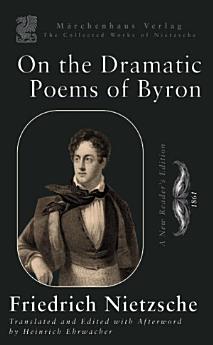On the Dramatic Poems of Byron: A New Reader's Edition
May 2024 · The Collected Works of Friedrich Nietzsche Book 2 · Marchen Press
Ebook
104
Pages
family_home
Eligible
info
reportRatings and reviews aren’t verified Learn More
About this ebook
This short essay is an undergrad paper of Nietzsche's while he studied at the University of Bonn. The original title is "Über die dramatischen Dichtungen Byrons", and was written in December of 1861, when Nietzsche was merely 17 years old. Already at this young age, Nietzsche displays here an advanced understanding of English Poetry and archetypal story telling. In this period at the University of Bonn, Nietzsche was deeply involved in philological studies before his philosophical pursuits took a more prominent role in his intellectual career, and was teaching himself Latin, Greek and Hebrew. This is a new reader's edition of Nietzsche's early 1861 essay. This work was published posthumously in the volume "Gesammelte Werke" edited by Peter Gast (a pseudonym for Heinrich Köselitz, a close associate of Nietzsche) and Elisabeth Förster-Nietzsche (Nietzsche's sister) in 1897. It was included in the second series of these collected works under the title "Philologica," which was published in 1897 and several editions after that. Here Nietzsche explores the dramatic qualities of Byron's works, examining how Byron's dramatic poetry contributes to and expresses the Romantic spirit, especially in relation to Goethe and Schiller. This is partly a Pathography, as Nietzsche analyzes Bryon's work in relation to his personal Psychology. We already see Nietzsche's proclivities towards the worship of the Übermench, as he praises Byron for being "free from religiosity" and morality. A central thesis of the essay is the portrayal of Byron's dramatic characters as extensions of his own psyche- which is quite advanced for a 17 year old. Byron's characters, from Manfred to Sardanapal, though diverse in their idiosyncratic manifestations, consistently reflect his underlying existential angst, his contemptuous resignation to the world, and his deep-seated longings for freedom and emotional truth. This is a critical observation that highlights Byron's limitations in character diversification, but also underscores the depth of his personal engagement with the themes he explored in his poetry. Philosophically, the young Nietzsche examines Byron's works through the lenses of existentialism and Romantic idealism, presenting his poetic endeavors as a profound exploration of human freedom, despair, and identity. This analysis elevates the discussion from mere literary criticism to a broader consideration of the human condition as reflected in Byron's dramatic poetry. In the following years of Nietzsche's life, he would begin to understand advanced philosophical concepts in essays such as "Fatum and History" and "On Theognis of Megara". This critical reader's edition presents a modern translation of the original manuscript, crafted to help the armchair philosopher engage deeply with Nietzsche's works through clean, contemporary language and simplified sentence structures that clarify his complex ideas. Supplementary material enriches the text with autobiographical, historical, and linguistic context, including an afterword by the translator on Nietzsche’s history, impact, and intellectual legacy, an index of the philosophical concepts he employs—emphasizing Existentialism and Phenomenology—a comprehensive chronological list of his published writings, and a detailed timeline of his life, highlighting the personal relationships that shaped his philosophy.
About the author
Friedrich Nietzsche (1844-1900) was a watershed German philosopher, cultural critic, poet, musician (briefly) and philologist (the study of ancient manuscripts) whose work has had a profound impact on modern intellectual history. Known for his critiques of European morality and religion (particularly Protestantism), Nietzsche's ideas on the "will to power" and the "Übermensch" have influenced a wide range of philosophical, literary, and psychological thought including thinkers such as Martin Heidegger, Albert Camus, Michael Foucault and the entire Postmodern religion.
Rate this ebook
Tell us what you think.
Reading information
Smartphones and tablets
Install the Google Play Books app for Android and iPad/iPhone. It syncs automatically with your account and allows you to read online or offline wherever you are.
Laptops and computers
You can listen to audiobooks purchased on Google Play using your computer's web browser.
eReaders and other devices
To read on e-ink devices like Kobo eReaders, you'll need to download a file and transfer it to your device. Follow the detailed Help Center instructions to transfer the files to supported eReaders.











